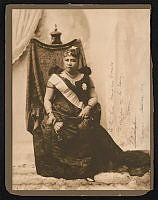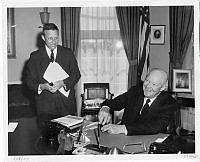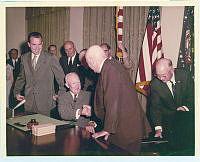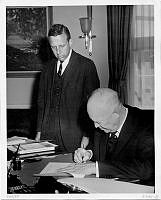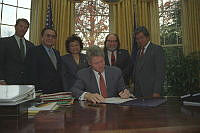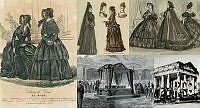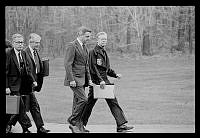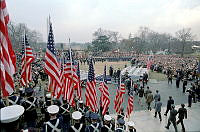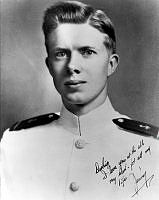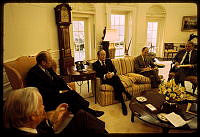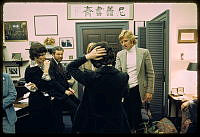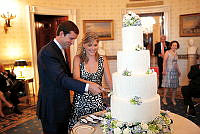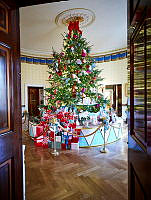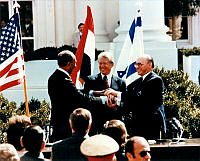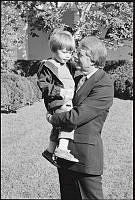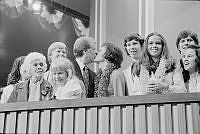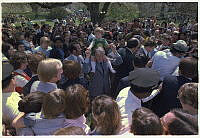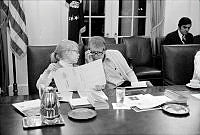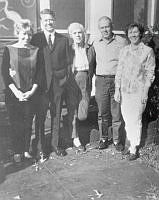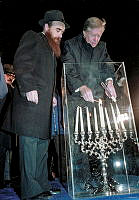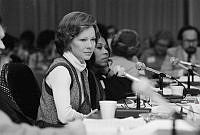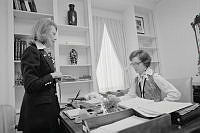Rules of Engagement
Ceremony and the First Presidential Household
Copyright © September 01, 1999 White House Historical Association. All rights reserved under international copyright conventions. No part of this article may be reproduced or utilized in any form or by any means, electronic or mechanical, including photocopying, recording, or by any information storage and retrieval system, without permission in writing from the publisher. Requests for reprint permissions should be addressed to books@whha.org
Shortly before Secretary of Congress Thomson arrived at Mount Vernon in April 1789 to announce that George Washington had been elected first president, a carriage departed the Potomac plantation headed for New York. Tobias Lear, Washington’s private secretary, was directed to precede his eminent employer to make ready the presidential household. When Lear arrived in the temporary national capital, he found that Congress had already engaged the house at No. 3 Cherry Street, the former residence of the presidents of the defunct Confederation Congress.
Aware of the likely results of the electors’ votes, Washington made arrangements for his trip. Strapped for cash, he borrowed £600 from Alexandria merchant Richard Conway to discharge some debts and to fund the eight-day journey to Manhattan. He said what would be his last last goodbye to his mother, Mary Ball Washington, in Fredericksburg, Virginia, and he made decisions on which household slaves would accompany him. When New York governor George Clinton offered his home to the first family until a fixed arrangement could be made, Washington politely declined. Since the government was providing him public funds for accommodations, he was reluctant to “be burdensome to Individuals.” Instead, he would “make it a point to take hired lodgings, or Rooms in a Tavern until some house can be provided.”' While Washington would never require such temporary “hired lodgings,” in effect he would be a tenant for two terms. In New York, the Cherry Street house was selected for him, and Washington later picked a second standing residence on Broadway when it was vacated by the French foreign minister. In Philadelphia, the City Corporation offered what Washington called “the best single House” in town.12
The first chief executive made do with three houses about which he had no say in original design or construction. This did not cause him distress. He had inherited a farmhouse at Mount Vernon at the age of 22 and spent the better part of four decades expanding, embellishing, decorating, redecorating, and refining. Washington had the ability to make a structure function as a family home, a business office, and an elegant setting for guests. Certainly, a good number of his fellow planters did the same, but none of them had as much at stake. Washington’s private home and public residence represented the nation’s indispensable leader. As the historian Forrest McDonald put it: “As a man idolized by the people—almost all the people, whatever their station in life—he could make it possible for them to indulge their habitual adulation of a monarch without reneging on their commitment to republicanism. As a symbol of the Union, he could stimulate, at least for a time, the emotional detachment to the Nation that normally requires centuries in the building.”3

Painter Daniel Huntington’s overworked imagination produced Lady Washington’s Reception in 1861, and A. H. Ritchie published it as an engraving after the Civil War High-style Victorian influences are evident, as no evidence exists for such elaborate decoration at the president’s house.
Library of CongressThe great trial that was the American republic in the last decade of the 18th century offered countless opportunities for enlightened heroics and stumbling miscues. Washington sensed this as acutely as any of his fellow citizens: “The eyes of America, perhaps of the world, are turned to this government, and many are watching the movements of all those who are concerned in its administration.”4 Of course he meant matters such as establishing relationships among the branches of government; negotiating with European powers of superior attitude and Native American tribes with complex leadership systems; and creating a favorable economic climate with trading partners while maintaining political distance from neighbors in the Western Hemisphere. But forming the president’s public image was not far from the top of Washington’s agenda. Charged with securing “the dignity and respect that [is] due to the first Magistrate,”5 Washington looked keenly to his household, for it was to the President’s House that the American public and foreign observers would also look for cues on future executive leadership.
If there was any doubt of the importance of associating George Washington, the spirit of the Revolution, and American leadership in the form of the new office of president, it was quickly extinguished during the triumphant journey from Mount Vernon to New York City. All along the way—in the cities of Alexandria, Baltimore, Wilmington, and Philadelphia and through scenes of triumph of the recent past in Princeton and Trenton—citizens scattered flowers, fired cannon, raised their glasses, presented speeches, uttered poetry, and sang secular hymns. If Washington was embarrassed by the adulation he had the sense to hide it, and he accepted each good wish with an earnest response or gesture.
Yet he was eager to begin. Governor Clinton and representatives of the state and city government led Washington, as a local newspaper stated, from his barge at Murray’s Wharf “to the house fitted up for the reception of his Excellency.”6 The house on Cherry Street, owned by Samuel Osgood, was three stories high and five bays wide. Washington was not consulted on the selection of the house or its furnishings. If he had been, he would likely have accepted whatever Congress deemed appropriate. He did, however, make many purchases for and some alterations to all three presidential homes once he was established in them.
Among the acquisitions made for Washington included an outlay of £400 for glass and Queen’s ware from William Williams and James Christie. Thomas Burling provided mahogany furniture: bedsteads, several dozen chairs, dining tables, knife boxes, washstands, and clothespresses. Burling’s shop also crafted fine inlaid card, breakfast, and tea tables. Washington admired Burling’s work and would later commission furniture that would travel home to Mount Vernon. Silver gleamed in flat-ware, candlesticks, tea wares and urns, glass lamps, bottle stands, and breadbaskets. Wilton carpets covered the floorboards, the kitchen was generously outfitted, and even a new chariot was ordered. After Martha Washington arrived, she would comment that the house was “a very good one and is handsomely furnished all new for the General.”7

A portrait of Martha Washington.
White House Collection/White House Historical AssociationTobias Lear would have particularly appreciated Mrs. Washington’s charitable remark. He witnessed the efforts to prepare the house. When Lear first saw the home, “it was then in a state of the greatest confusion —pulling down—putting up— making better & making worse.” Masons, blacksmiths, and carpenters were engaged in a number of tasks. A call bell system was repaired, a chimneypiece installed, stables were built behind the house, and the stable yard was prepared for the president’s coach and six. At last, three cleaning women put the finishing touches on the Cherry Street residence, and thus, as Lear noted, “by spirited exertions, it was got into good order by the arrival of the President.”8
To manage the household staff, Lear hired Sam Fraunces, former proprietor of New York’s Fraunces’ Tavern, as steward in charge of the kitchen and housekeeping. According to Lear, who would often sit at the president’s table, Fraunces “tosses up such a number of fine dishes that we are distracted in our choice when we set down to table, and obliged to hold a long consultation upon the subject before we can determine what to attack.” Catering to the Washingtons’ tastes, Fraunces created a number of seafood specialties.9
Lear assembled more than a dozen white servants to support the president’s household: a coachman, porter, cook, foot men, maids, and laundresses. On occasion, Lear or Fraunces would hire carpenters, black smiths, chimney sweeps, painters, or whitewashers. Washington brought seven slaves from Mount Vernon, including postillions, maids, and a valet de chambre. At any given time, then, there may have been 20 household staff. In addition there were five secretaries: Lear, who had tutored Martha’s grandchildren at Mount Vernon; David Humphreys, General Washington’s former aide-de-camp; William Jackson, former assistant secretary at war; Thomas Nelson, son of a former Virginia governor; and Robert Lewis, Washington’s nephew. In May 1789, President Washington was joined by his wife Martha and two of his stepchildren, Nelly and George Washington Parke Custis.10
The first floor of the Osgood house provided space for Washington’s office, a large dining room for formal dinners and receptions, and a smaller dining room in the rear that could be used as a parlor or to accept overflow in the case of larger dinners. The second floor offered a drawing room and bed rooms for the immediate family. The secretaries occupied two bedrooms on the third floor, with some of the white servants living in the attic. Other staff, white and black, lived in or above service buildings behind the house. A visitor might bump into Mrs. Washington’s hair dresser, Nelly’s French tutor, or beggars and musicians at the front stoop. It is easy to imagine the crowded conditions and the constant flow of bodies through and around the president’s house. And, of course, the nation wanted to do business with the chief executive.
Almost immediately upon his inauguration on April 30, Washington broached the need for an official “line of conduct,” or what would later be known as rules of protocol. Reflecting on the early scene at Cherry Street, as unmanageable numbers of public officials, private citizens, and foreign ministers visited the president, Washing ton wrote: “I was unable to at tend to any business whatsoever; for Gentlemen, consulting their own convenience rather than mine, were calling from the time I rose from breakfast— often before—until I sat down to dinner.”11
On the surface, these matters seem hardly important enough to occupy the time of the president, but Washington knew that in small details resided the success or failure of larger concepts. He also knew enough about human nature to realize he risked offending someone if the structure of presidential protocol remained ambiguous.
In confidence, Washington consulted with Vice President John Adams, Virginia congressman James Madison, and New Yorkers Alexander Hamilton and John Jay. Responses from Hamilton and Adams survive. Washington wanted to know their thoughts about how the president could best strike a balance both as an elected official accessible to his fellow citizens and as a chief executive for whom a good degree of re spect was not only due, but required for establishing the authority of the office at home and abroad. Once this protocol was set, how should it be announced? How often, in the course of a week, should he be available for “visits of Compliment”? What manner of public entertaining should the president offer, and who should be invited to private dinners? How should he respond when invited to tea or dinner?12
On the surface, these matters seem hardly important enough to occupy the time of the president, but Washington knew that in small details resided the success or failure of larger concepts. He also knew enough about human nature to realize he risked offending someone if the structure of presidential protocol remained ambiguous. It would not have surprised Washington, for example, to know the opinions of Senator William Maclay of Pennsylvania as he recorded them in his diary: “General Washington stood on as difficult Ground, as he ever had done in his life. That to suffer himself to be run down on the one hand by a Croud of Visitants so as to engross his time would never do, as it would render the doing of Business impracticable. But on the other hand for him to be seen only in public on Stated times like an Eastern Lama would be equally offensive.”13
After deliberating on the advice given by Adams and others, Washington decided on one reception, or levee, on Tuesday afternoons for gentlemen to present their compliments. In a notice published in a New York newspaper, such visits “on other days, and particularly on Sunday, will not be agreeable.”14
These were rather stiff affairs. Visitors were announced by one of the secretaries and briefly exchanged bows with Washington, then took their place in a line that formed around the room. After about an hour of this, Washington approached each gentleman, said a few cordial words, bowed, and retired.

A view of Mount Vernon, George Washington's home.
Library of CongressOn Friday evenings, “Lady” Washington hosted her levee for ladies and gentlemen, and her husband would often circulate during these more relaxed gatherings, where lemonade, tea, cake, and ice cream were served. Abigail Adams, wife of the former minister to Britain and the vice president, John Adams, noted that after a couple was introduced to Mrs. Washington, “The President then comes up and speaks to the Lady, which he does with a grace, dignity & ease, that leaves Royal George far behind him.”15 Formal invitations were not required for either of these weekly events, simply member ship in that self-defining club known as “respectable characters.”
Washington reserved the right to offer informal invitations to Thursday afternoon dinners. The capacity of the dining room at Cherry Street limited the number of guests to about a dozen. Washington tried to distribute the invitations so that, eventually, all congressmen, foreign ministers, and other distinguished officials would have the honor to join the Washing tons. These dinners were in dis tinct contrast to some of those hosted by former presiding officers of Congress under the Confederation. Washington had heard that these public entertainments were so frequent and liberal in their nature, with the table so crowded “with mixed company [that] the President [was] considered in no better light than as a Maitre d’hotel.”16 Washington would not make this mistake, even at the danger of boring his guests.
Senator Maclay described one dinner as
"the best of the kind I ever was at. . . . First was soup, Fish roasted & boiled meats, Gammon Fowls &ca.... The dessert was, first Apple pies puddings &ca. Then iced creams Jellies &ca. Then Water Melons Musk Melons apples peaches nuts. It was the most solemn dinner ever I eat at, not an health drank, scarce a Word said. Un till the Cloth was taken away. Then the President filling a Glass of Wine with great formality drank the health of every individual by name around the Table."
After the ladies retired, several of the male guests attempted a number of jokes, which Maclay thought fell flat. “The President kept a fork in his hand when the Cloth was taken away I thought for the purpose of pick ing nuts. He eat no nuts but played with the Fork striking on the Edge of the Table with it.”17
While Washington would never allow his fellow citizens to become overly “familiar” with him, he made it clear that it was their call that he had answered, that he served their nation’s interests above all.
Evidence of Washington’s reserved nature is plentiful, but it may be misleading to believe that the strictures of protocol enhanced this attribute; indeed, it is likely that Washington felt comfortable within their con fines. However, he was not a prisoner to this etiquette or to the house on Cherry Street. Afternoons were spent walking down to the Battery, making calls on friends, riding with the family in the coach, and going to the circus. The theater, Washington’s passion, drew out the first family in the evenings. The household accounts record numerous outings in which Washington would have made contact with the public in less formal settings.18 More dramatic efforts by Washington to seek out Americans and give them the opportunity to meet their president were displayed during his national tours. During his first term, Washington visited every state in the Union. He traveled throughout New England in autumn 1789 and spent two months, moving by coach and horseback, on his journey through the southern states in 1791, covering 2,000 miles. While Washington would never allow his fellow citizens to become overly “familiar” with him, he made it clear that it was their call that he had answered, that he served their nation’s interests above all.
Considering the emphasis Washington placed on public presentation, it is easier to understand why he pounced on a chance to move out of the cramped Cherry Street house to a more commodious and elegant residence at Nos. 39-41 Broadway. In February 1790, the president agreed to terms with the owner, Alexander Ma comb, at $1,000 per year. The house was situated in a more fashionable and convenient site near Trinity Church, as opposed to Cherry Street’s location on the northern outskirts of the city proper. Built in 1787-88, it was four stories high with an attic and measured 56 feet in width. Col. John May saw the houses still under construction and exuberantly stated that “they are by far the grandest buildings I ever saw and are said to excel any on the continent. In one of the entry’s I travelld up 5 flights of stairs.”19
Although Congress had spent £5,000 to furnish the Osgood house, Washington could not resist an opportunity to spend an additional £665 to purchase furniture and china left behind by the previous ten ant, the French foreign minister, comte de Moustier. On February 3, Washington “viewed the Apartments in the Ho[use] of Mr. Macombe—made a disposition of the Rooms—fixed on some furniture of the Ministers (which was to be sold & was well adapted to particular public rooms) and directed additional Stables to be built.” A few days later, Washington returned and met with a carpenter to build the stables. The president supplied the precise dimensions: “30 feet sqr., 16 feet pitch, to contain 12 single stalls; a hay loft, Racks, mangers &ca.—Planked floor and underpinned with Stone with Windows between each stall.”20 A wash house in the rear yard was also convenient to the residence.
There were fine public rooms on either side of the entrance, one of which measured 32 by 22 feet with a fireplace at each end. The capacity for dinner was twice that which could be accommodated at the first house. The papered walls were hand-colored. Through glass doors at the back of the house, the family enjoyed a clear and expansive view of the Hudson River. Washington asked Clement Biddle, a Philadelphia merchant, to acquire for him a carpet for this room, specifying that “a Pea Green Ground, with white or light flowers or spots would suit the furniture.”21 Although Washington claimed that a carpet of the quality he sought could not be had in New York, he soon after found one there. The Washingtons moved in on February 23, and three days later Mrs. Washington entertained “a numerous company of Gentlemen & Ladies.”22

A portrait of George Washington.
White House Collection/White House Historical AssociationTwo other receptions in 1790 marked the beginning of traditions that would extend well into the 20th century: New Year’s Day and Independence Day were celebrated at the president’s house. The first day of 1790 coincided with Mrs. Washington’s scheduled levee, and the combination bedazzled even those who had witnessed the pomp of the royal court. Abigail Adams wrote that it was “as much crowded as a Birth Night at St. James, and with company as Briliantly drest, diamonds & great hoops excepted.”23 In 1789, Washing ton was recovering from a serious illness on July 4, but the following year he and Mrs. Washington received company for the occasion. Since the anniversary fell on a Sunday, the gathering occurred the next day. Members of Congress adjourned early and proceeded to Washington’s home, where they were treated with punch, wine, and cake. Afterward they at tended a service at St. Paul’s and heard remarks by a prominent New Yorker, Henry Brockholst Livingston.24
By the end of July, Congress passed the Residence Act, which called for the removal of the national capital from New York to Philadelphia, where it would reside until the year 1800. At the dawn of the new century, the federal government would inhabit the Federal City on the Potomac River near Georgetown, Maryland. President Washington signed the bill into law and, just over a year into his first term, he began preparations for the move to the most sophisticated city in America.
On August 30, 1790, Washington bade farewell to New York, a city that had played a prominent role in his life as general and president. He would never return. As Congress had adjourned and would not be called back into service until December, Washington and his family headed to Mount Vernon. En route he stopped in Philadelphia for the purpose of securing a residence. When he arrived, he found that the City Corporation had already selected the home of Robert Morrisat 190 High Street. The search committee reported “that no House was to be found in the City that would accommodate the President & his Family without Additions or Alterations, that the House of Robert Morris Esquire approached the nearest of any to what was desired & was capable of being rendered sufficiently commodious at the least Expence.” It was accepted that some changes might be required, and the Corporation advanced Morris funds for this purpose.25 Indeed, Washington immediately recognized that, while it was the finest house in Philadelphia, his burgeoning household would not fit in the existing structure.
To the right of the rectangular entrance hall, a small family dining room faced the street, with the larger state dining room looking out into the rear yard, with a southern exposure. On the second floor, two drawing rooms provided the space for the levees, which remained on the same schedule that Washington had initiated in New York. The state dining room and a drawing room above were enlarged by constructing bow windows—one of the major alterations. Washing ton noted that the back of the house, “with the aid of one room with the partition in it. . . will be Sufficient for the accomodation of Mrs. Washington and the Children, and their Maids; besides affording me a small place for a private Study and dressing Room.” Tobias Lear and his wife stayed on the third floor, as did several secretaries. Because of the layout of the house, the public office was situated on the third floor—a long climb for those wishing to do business with the chief executive or his key aides. Washington was resigned to this arrangement but not keen about visitors who “will have to ascend two pairs [flights] of stairs, and to pass by the public rooms to go to it.” All in all, he hoped the alterations and decorations would be done “in a plain and neat manner, not by any means in an extravagant style.”26
As the first president, Washington’s primary guide was his character.
The steward and servants lived in several spaces. They shared four rooms in the attic and a room above the stable. Washington called for a new servant’s hall (18 by 52 feet) to be erected in the rear yard for the remainder of the staff, and Morris’s cow house was converted to stables for the horses. The complex of buildings be hind the house also included a wash house, smokehouse, ice house, coach house, and kitchen.27
While Washington took care of personal business at his Virginia estate during the autumn of 1790, Tobias Lear made arrangements to ship the president’s belongings from New York to Philadelphia. The move also proved to be a convenient time to take stock of the hired servants and leave behind those who had not performed up to Washington’s standards. A good amount of correspondence was taken up in the decision to hire Sam Fraunces and bring him to Philadelphia. While this was not immediately accomplished, Fraunces would return to the household in May 1791. The slaves from Mount Vernon included Hercules, a cook, and
his son, Richmond, who assisted him; Austin, a postillion; Christopher Sheels, Washing ton’s valet; and Oney Judge, Mrs. Washington’s maid.28 When the Washingtons arrived in late November 1790, the work was not completed, but the house was made ready for the first reception on December 7.
If Philadelphia society enhanced the glitter of the levees, it did not alter the structure of them. Now that his “line of conduct” was well established, Washington consistently employed it. It did not sit well with republicans, who increasingly criticized the administration privately and in the news papers: the presidential coach and six rumbling down the stony streets of Philadelphia, the major domo announcing each gentleman as he entered Washington’s parlor at the appointed time, the stilted and prescribed dinners. Secretary of State Thomas Jefferson commiserated with James Madison. He recalled a remark made by the Virginia congressman when Jefferson took his post in New York, “that the satellites and sycophants which surrounded [Washington] had wound up the ceremonials of the government to a pitch of stateliness which nothing but his personal character could have supported, and which no character after him could ever maintain.”29
As the first president, Washington’s primary guide was his character. Jefferson would find that when he assumed the position of executive leadership in 1801, he could not “maintain” what Washington had begun, but he was wise enough not to try. Jefferson, Madison, and the others who followed would seize the chance to make their own statements.













